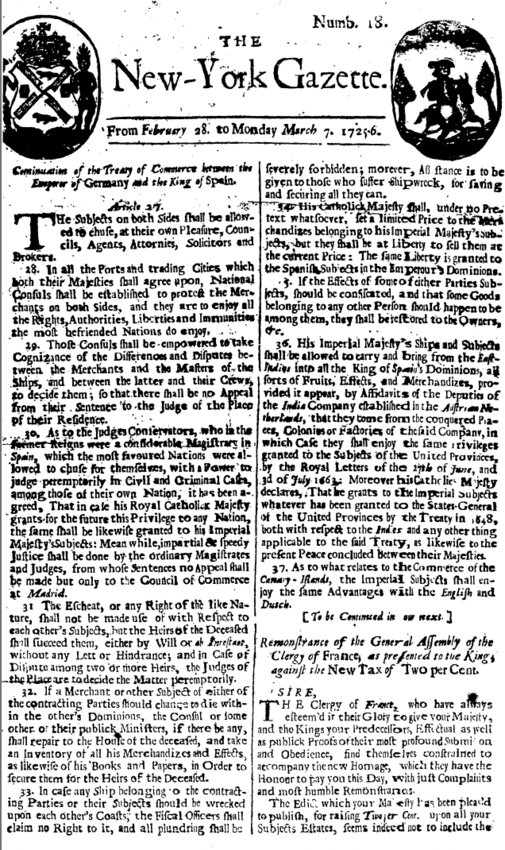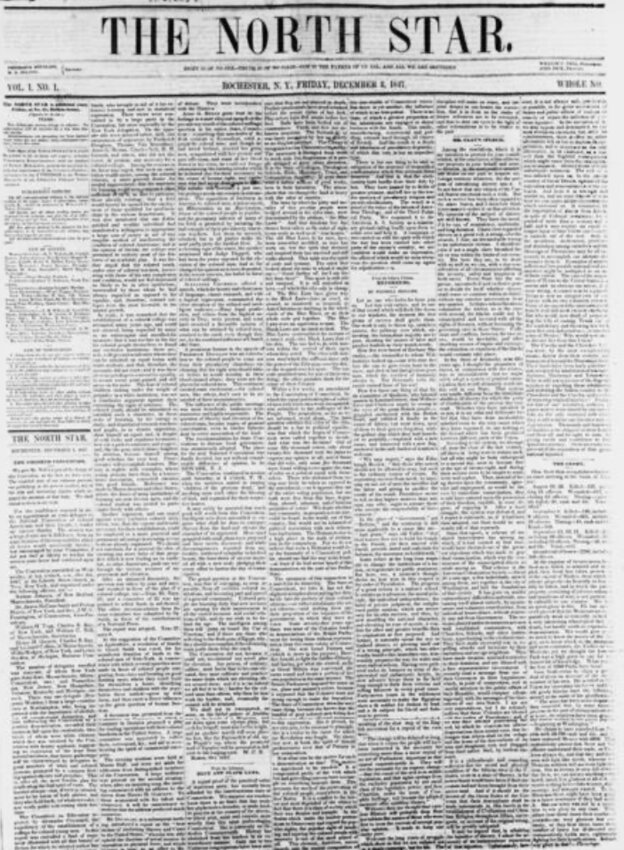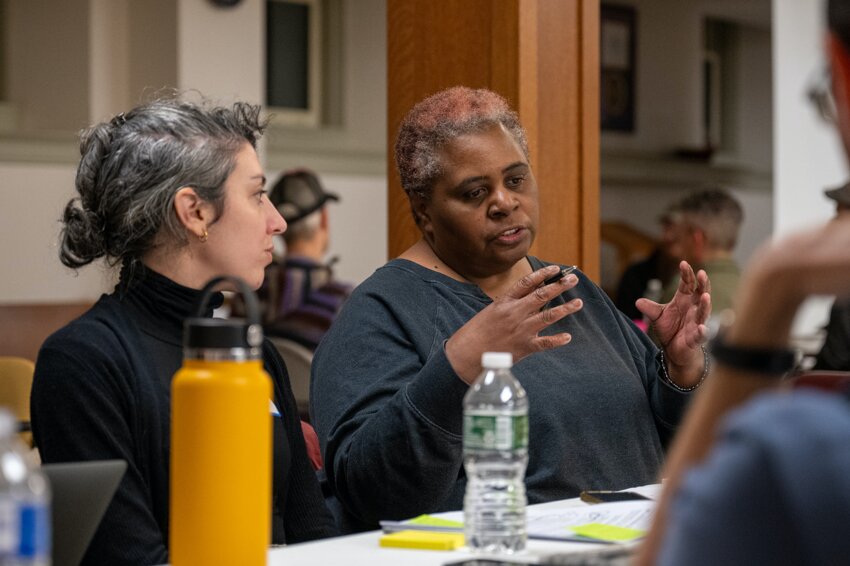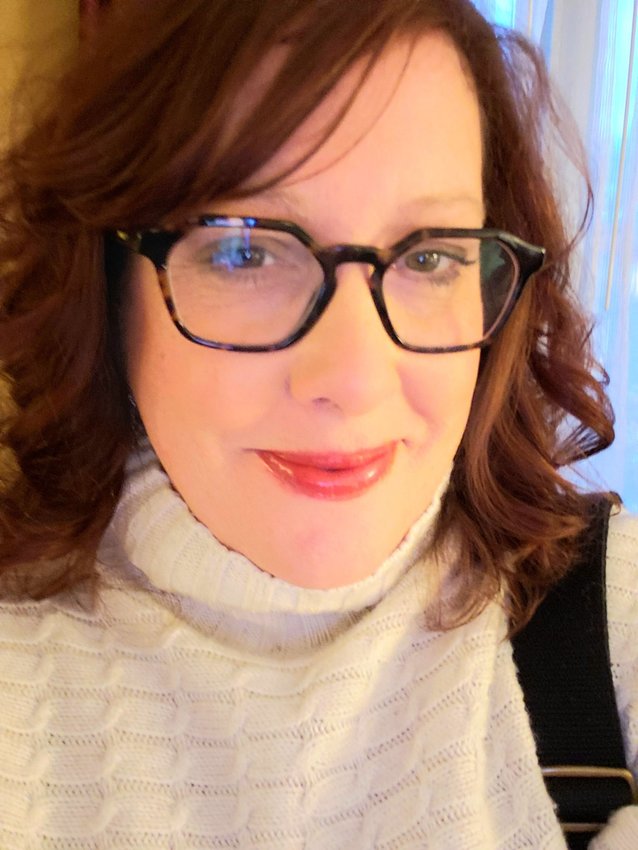New York is credited with a lot of American newspaper firsts and milestones. The New York Gazette, published by William Bradford, debuted in 1725. In 1733, a second paper — The New-York Weekly Journal — was founded by Publisher John Peter Zenger. He was charged with libel in 1735 and sent to jail. According to the New York State Library, Zenger’s wife, Anna, carried the paper forward, making her the first woman to write, edit and publish a newspaper in New York state.

New York’s first Spanish-language newspaper, El Habanero, was founded in the 1820s. So, too, was the first African American newspaper, Freedom’s Journal. In 1837, The Emancipator was founded, and a decade later, Frederick Douglass began publishing The North Star in Rochester, New York. The following year, the Associated Press (AP) was born when six New York publishers met and formed the collaborative Associated Press of New York.
New York publishers have long enjoyed state press association representation.
“We’re not sure whether we’re the oldest press association in the country or the second oldest, but either way, it’s a matter of months that distinguishes that statistic,” Michelle Rae explained. Rae is the executive director for the New York Press Association/New York Press Service. The position gives her a statewide view of the local news landscape.

“New York is different from most states because we don’t have the publicly traded ownership percentages that many other states have,” Rae said. “New York probably has the smallest percentage of chain ownership of anybody. We still have well over 500 newspapers printed in New York. We have 55 dailies and 397 local community weeklies. We have 84 ethnic community papers — and that's in addition to the 397 (weeklies).” There is also a growing roster of digital news publishers. She estimated that number is around 730.
“Then, if you add in radio and television, the news landscape here in New York is pretty robust,” she said.
“Our newspapers are challenged, just like everybody else, by the cost of postage, paper and ink,” Rae said. “Housing is a huge issue in some parts of New York, like on Long Island. It’s really difficult to hire because the cost of living is so high. … But we still have over 200 community newspapers on Long Island.”

Rae is lobbying for the state-level Local Journalism Sustainability Act (LJSA). The bill would provide tax credits (for five years) to news businesses expressly for hiring and retaining newsroom personnel.
“There’s a tremendous amount of support for that, and I hope it will pass,” she said. “We're increasing the number of sponsors for that legislation almost daily.”
From her leadership position at the press association, she aims to deliver practical resources to members. The association runs a “libel hotline” staffed by 21 expert attorneys. They administer a paid summer internship program and publish the “NewsBeat” newsletter for and about members.

She hears their challenges. Printing-industry consolidation has been “incredibly painful for the papers,” she said. They’re also buckling under the weight of overhead costs. Still, you see essential journalism being produced and publishers who are out and about in their communities.
“They’re at the fire department. They’re at the school board meetings. They have their fingers on the pulse of the communities that they serve. And when you go to the PTA meeting, a football game or to the supermarket, and everybody knows who you are, you better have gotten the story right,” she said.
“Community newspapers are — I hate to say because it sounds like a cliché — but they’re the glue that holds their communities together,” Rae concluded.
A publisher’s perspective

Mark Vinciguerra is the publisher of Capital Region Independent Media, which publishes seven local news titles. Before the position, he was a radio journalist and news director. Thirty-three years ago, he became sales director for a local paper, and he’s been in newspapers ever since. One of the papers in his group, the The Whitehall Times, dates back to 1815. He takes pride in that legacy.
He knows what New Yorkers expect from local news: “Local journalists in the street and local advertising reps on the street are paramount,” he said. Yet hiring and retention — for newsroom and ad sales roles — are constant concerns.
Another is retaliation. Vinciguerra cited the case of New York publisher Decker Advertising, Inc., which operates a commercial print business and two local papers, The County Shopper and The Reporter. In December 2023, Decker Advertising filed suit against Delaware County, New York, which had rescinded the publisher’s “paper of record” designation — allegedly because of unfavorable reporting — effectively starving the business of public notice revenue.
“As a smaller publisher, losing tens of thousands of dollars is a threat, and you can be strong-armed. It keeps you up at night,” Vinciguerra said.
He knows these issues aren’t exclusive to New York, and despite them, he’s bullish on the future. His sustainability plan focuses on operational efficiencies and innovation. They’ve invested in broadcast-quality camera equipment and plan to produce more visual journalism. They put the new equipment to work at Granville's annual lighted tractor parade. It’s a town of roughly 6,600, but the Facebook Live broadcast got 14,000 views.
Vinciguerra hopes the LJSA will be part of the governor’s 2024 budget. He trusts it will help restaff newsrooms around the state, but it would also present a challenge for his business. To qualify for the tax credits, they must move several part-time and freelance contributors into full-time roles.
As the past president of the New York Press Association and a current New York News Publishers Association board member, Vinciguerra sees the need for support, resources and advocacy in the state.
“Both press associations are vibrant, and I think it really reflects the vibrancy of newspapers in New York,” he said.
Nonprofit news in New York

Rebecca Klein is the publisher of New York Focus, a nonprofit. She came to the role after a career in for-profit news reporting on education.
“During that time, I saw relentless rounds of cuts. We had been sold to different corporate owners multiple times,” she recalled. “I wanted to be part of helping to build something more sustainable at the local level.”
New York Focus started with just $75,000 in seed money and a mission to cover state government and public policy.
“There’s truly been a decimation of statehouse coverage in recent years,” she said.
As of December 2023, New York Focus had 10 full-time employees, including Editor-in-Chief Akash Mehta and Managing Editor Maia Hibbett.
Their journalism is published on a website, in a newsletter and on other news sites thanks to publishing partnerships. Since the 2020 launch, Klein said they’ve amassed a newsletter audience of 8,000, with an open rate of 50%. “I think we had over a million organic visits to our website [in 2023], about double what we had [in 2022].”
New York Focus' donors, including larger philanthropic organizations, are named on the website. Klein wants to diversify funding sources, inspiring individual donors, too.
“We seek to be an outlet funded by New Yorkers for New Yorkers. We feel like we will be able to build more consistent funding if it is from people who live here and see the impact this work has on their community,” Klein said.

They’ve started to travel the state to meet face-to-face with the public on a “listening tour.” Their first two stops were Rochester and Albany, where they asked residents for thoughts on local news — what could be better, how they prefer to receive their news, and what issues matter to them most.
Three years in, the impact of New York Focus is measurable.
“One series we did was a partnership with The City, a nonprofit newsroom in New York City, and it was about how New York State had been failing to enforce a law that had passed around campaign finance,” Klein said. “This law was designed to make donors to major campaigns more transparent. … This law passed, but no one followed up to see if it had actually been implemented. We went back and found that the authorities had totally neglected enforcement of what was a pretty landmark law. After we did the series, they started enforcing the law.”

Another report shed light on a state prison policy that banned people in prison from publishing works of writing or art. It sparked public outcry, and the agency changed the rule. Their reporters uncovered a loophole that prisons were exploiting — illegally holding inmates in solitary confinement but calling it by another name. “They were violating the law’s intent, and since then, legislation has been introduced to try and reverse some of these trends.”
“We have found [New York] to be a really friendly environment for collaborations, and that other outlets have been eager to find ways that we could lift up that New York news media ecosystem. That's been heartening,” she concluded.
 Gretchen A. Peck is a contributing editor to Editor & Publisher. She’s reported for E&P since 2010 and welcomes comments at gretchenapeck@gmail.com.
Gretchen A. Peck is a contributing editor to Editor & Publisher. She’s reported for E&P since 2010 and welcomes comments at gretchenapeck@gmail.com.
Comments
No comments on this item Please log in to comment by clicking here